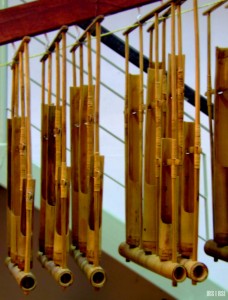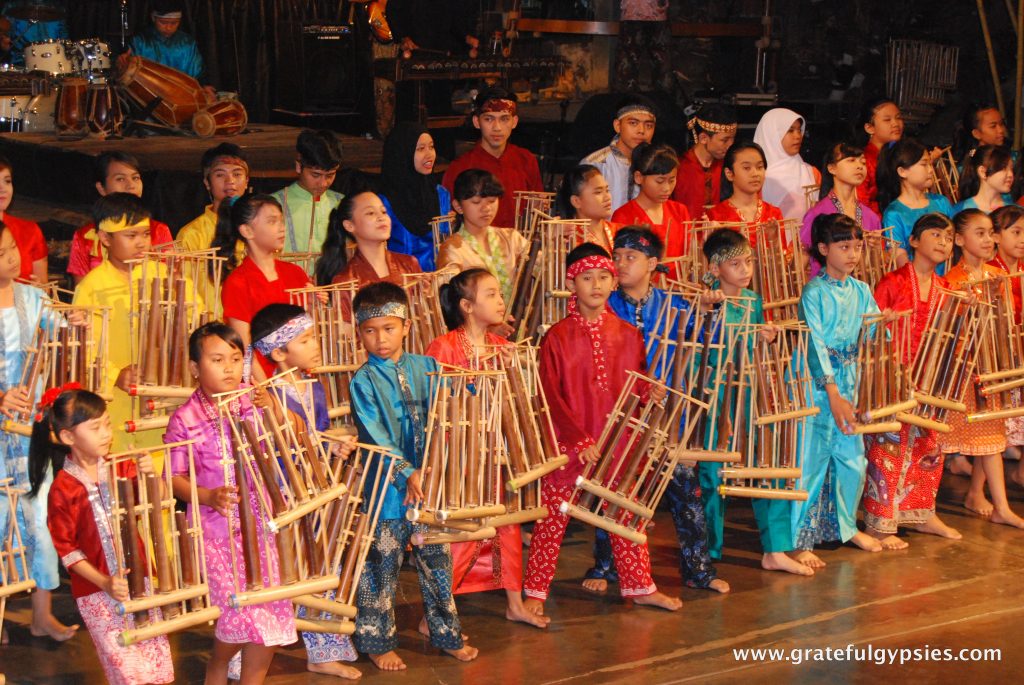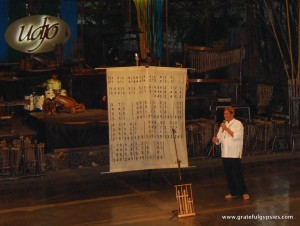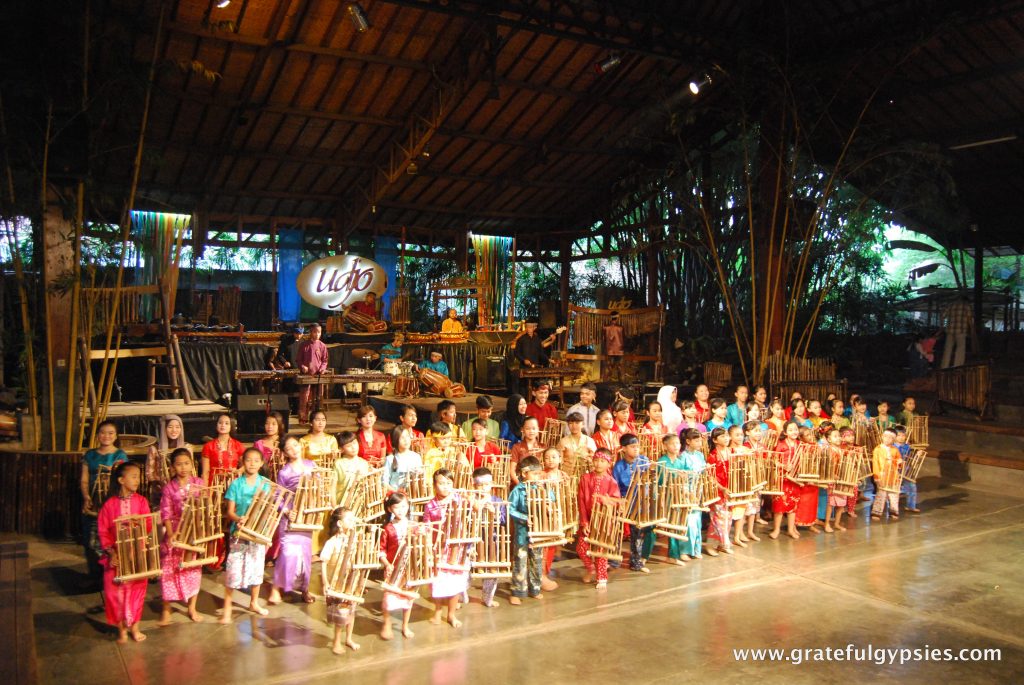Indonesian Culture – Angklung Posted by sasha on Oct 27, 2014 in Uncategorized
Music plays an important role in Indonesian culture, and it should come as no surprise that there are hundreds of different styles spread out across this vast archipelago nation. For those interested in music, traveling across Indonesia’s many islands and taking in live performances everywhere you go is a treat for the ears. Whether it’s in a theater or simply a street corner of a bustling night market, music is all around in Indonesia. During my recent travels across Java and Bali, I was able to take in quite a few traditional performances, such as the Ramayana ballet at the Prambanan temples, a kecak performance in Ubud, wayang kulit (shadow puppets) in Yogyakarta, and so much more. I’ll be covering traditional music and performances here over the next few months, and our musical journey begins in West Java with what is perhaps the country’s most famous instrument.
The Angklung
Listed in 2010 as a “Representative of the Intangible Cultural Heritage of Humanity” by UNESCO, this traditional bamboo instrument is a vital part of Sundanese culture and it has spread to other parts of Indonesia, Southeast Asia, and even as far as the United States. The name comes from a Sundanese word angkleung-angkleungan – the movement of the player and the “klung” sound that the instrument produces. Others believe the name comes from two Balinese words – “angka” (tone) and “lung” (broken), an “incomplete tone.” It is made by taking 2-4 bamboo tubes and binding them to a frame (also made of bamboo) with rattan cords. Each angklung produces a single note or chord when shaken or tapped, so a group of performers needs to play together in order to create melodies. This style of playing teaches cooperation, and the result is a truly beautiful sound.
History
Originally, they served a religious ritual function – they were meant to invite Dewi Sri (goddess of rice and fertility) to bless the land and encourage a bountiful harvest. A legend says that the music of the angklung persuaded the goddess to descend from the heavens and bless the crops after a particularly bad harvest in a West Java village. During the Kingdom of Sunda, they were also used to signify the time for prayer and as martial music in the Bubat War. The oldest surviving angklung was made in the 17th century and found in Jasinga, Bogor. The oldest tradition for this instrument is known as Angklung Buhun (ancient angklung), and it is still used in some villages for ceremonies. Traditionally, angklung had been tuned to a pentatonic (five tone) scale. That was until 1939, when Daeng Soetigna (a music teacher) redesigned it as a diatonic (eight note) instrument. This modern version – called the Padaeng Angklung – made it possible for many more songs to be performed on the angklung, including popular western compositions. This has led to a sort of renaissance for the traditional instrument, as it has gained popularity both domestically and internationally. Just watch this guy jammin’ out Rih-Rih’s “Umbrella” on an angklung:
Making an Angklung
Assembling a quality angklung is no easy task, and the lengthy process begins with the selection of bamboo. Even doing this is quite complex – the bamboo must be between four and six years old, and it must be cut in the dry season between the hours of 9 AM and 3 PM. And that’s just the beginning! After the bamboo is finally ready, the three parts of the angklung must be prepared: the voice tubes, frame, and base. Next, a master craftsman will tone the tubes by shaping them with a knife. Finally, the instrument is assembled by attaching the tubes to the frame and tying them with the rattan cords. For a more detailed explanation, check this website.
Watch how angklung instruments are made.
Modern Angklung
The father of modern angklung, Daeng Soetigna, passed away in 1984. His assistant and apprentice, Udjo Ngalagena, had the tough task of filling his shoes. Along with his wife, they started the Saung Angklung Udjo (Udjo’s house of angklung). Built to conserve and promote this traditional instrument and the wonderful music it creates, this workshop and performance hall is now a major tourist attraction in Bandung, West Java. Every evening, tourists can enjoy a performance here put on by a large group of mostly children from the surrounding villages. Here, the children can study the traditional instrument, have fun with friends, and even earn money for their family from the performances. Although Udjo himself passed away in 2001, his children have kept the place running and it remains a must-visit destination for tourists in Java. It’s even the #1 attraction in Bandung on TripAdvisor, and I can speak from experience that is well worth a visit to learn more about this traditional instrument and enjoy the performance. Tourists can even join in the fun and learn to play a bit.
More Than Just an Instrument
Just as humans, an angklung can not be solitary. The instrument simply will not work with only one tube, just as humans are meant to be surrounded by others throughout life. Humans are social animals, and we are not meant to live in isolation. Similarly, the instrument needs multiple tubes to create the pleasing sounds it is famous for. The different sizes of the tubes also represents human life – the shift from the small to the large signifies human growth in a lifetime. When the tubes are shaken, a harmony is created. All humans of different shapes and sizes must come together to create some kind of harmony in this world. Deep stuff, isn’t it?
A New World Record
It is believed that a new Guinness World Record was recently set in Adelaide, Australia, as a group of over 6,100 people joined together to play angklung. The group performed “Waltzing Mathilda” and “Happy Birthday” and appears to have broken the previous records set in Beijing (2013) and Washington D.C. (2011). It’s amazing that this instrument has the power to bring thousands of people together in countries as far away from each other and diverse as the USA, China, and Australia, and hopefully it will be played and appreciated for generations to come.
A clip from Indonesian news about the new record setting performance in Adelaide.
The previous record, set in Beijing in 2011.
The older record breaking performance in DC back in ’11.

Build vocabulary, practice pronunciation, and more with Transparent Language Online. Available anytime, anywhere, on any device.
About the Author: sasha
Sasha is an English teacher, writer, photographer, and videographer from the great state of Michigan. Upon graduating from Michigan State University, he moved to China and spent 5+ years living, working, studying, and traveling there. He also studied Indonesian Language & Culture in Bali for a year. He and his wife run the travel blog Grateful Gypsies, and they're currently trying the digital nomad lifestyle across Latin America.








